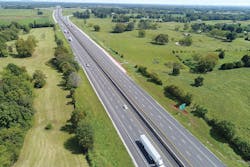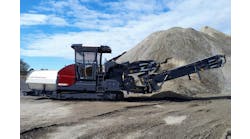Scotty’s Contracting, out of Bowling Green, Ky., has a long familiarity with I-65.
They have been the prime contractors on a comprehensive expansion of 92 contiguous miles of the interstate in the state of Kentucky—work that dates back to the 1990s and is presently still ongoing near Elizabethtown, the northern end of the overall corridor work. One stretch of the interstate that got its six-lane expansion back in the early 2000s came due this past year for a new driving surface. Commensurately, an interchange that feeds both the city of Bowling Green and the General Motors plant that manufactures Corvettes and employs a significant number of townsfolk in Warren County was in need of a complete rehabilitation. Once again, Scotty’s stepped in, and the resulting work earned a 2017 NAPA Quality in Construction (QIC) Award for “exemplary quality asphalt paving.”
Dan Gallagher of Gallagher Asphalt Corp., and 2017 NAPA Chairman, said of the project, “The I-65 project is a great example of the quality work that Scotty’s Contracting and the rest of the asphalt industry is doing. This project was independently rated by NCAT using qualitative standards and earned a 2017 Quality in Construction Award because Scotty’s exceeded these rigorous standards.”
On the mainline
Over the course of 40 years in business, Scotty’s is no stranger to NAPA recognition: The company earned a 2015 QIC distinction for a portion of the I-65 expansion work that took place in Barren and Hart counties, as well as a 2013 award for the Exit 20 interchange off I-65 in Bowling Green and countless others for other, unrelated projects. The relationship between Scotty’s and the Kentucky Transportation Cabinet (KTC), the project’s owner, has been long and deep.
“Scotty’s has been the prime contractor for the entire I-65 widening, since the 1990s,” KTC District Engineer Joseph Plunk told Roads & Bridges. “They have a long history of I-65 work, and they understand the traffic patterns and volumes, the demands and expectations from our freight partners, such as GM. There’s a lot of mutual understanding there. The quality of their work speaks for itself.”
This project’s limits ranged from mile marker 25.2 to mile marker 35.26, across the six-lane interstate. I-65 carries 12-ft lanes with 10-ft outside shoulders and 12- to 14-ft interior shoulders. The pavement reached the end of its surface life, and mill and inlay was required—a fairly straight-forward task, considering that the base and subgrade had many more years to give. Still, I-65 is the highest trafficked north-south truck corridor in all of Kentucky. Annual average daily traffic across the project limits exceeds 60,000 vehicles per day, of which approximately 19-23% is truck traffic. The GM plant is largely to thank for that—“This stretch goes through the northern portion of the city of Bowling Green and is adjacent to a Corvette plant. The middle of the project is right about where the Corvette plant is,” Tim Sharp, KTC, manager of project delivery and preservation, told Roads & Bridges—but the Bowling Green area also houses the Fruit of the Loom International Headquarters, as well as untold numbers of supplier-based businesses related to the GM facility. Consequently, creating a pavement that could both provide a long service life and do so with a smooth, safe ride was paramount.
“The surface was severely aged,” Mike Law, vice president of materials for Scotty’s, told Roads & Bridges. “There was significant cracking and the smoothness was poor. There was joint cracking and so forth. The mainline paving was a mill and inlay of 1.5 in. There were some base failures, but nothing significant, though we had to address the volume of freight traffic. We used a leveling course to deal with most of that. The inside and outside shoulders got a fog seal. And we did the striping and ground in rumble strips, both inside and outside, post-pave.”
A 12.5-mm Superpave 76-22 was devised for the 1.5-in. inlay, totaling just under 38,000 tons. The mix was made at Scotty’s Astec 500-ton-per-hour double-drum plant in the southern section of Bowling Green, and was put down by a train that consisted of a Roadtec SB2500E Shuttle Buggy feeding a Cat AP1000E paver.
“The density spec in Kentucky ranges 92-96% for asphalt,” Jon Kemp, QC manager for Scotty’s, told Roads & Bridges. “We were able to attain it; we averaged a density of 93.9% on that surface course. Most situations, we did four to five passes on a breakdown roller and a finishing pass each on a vibe roller and static roller, which is the common rolling pattern for this mix. We had a couple of 84-in. Cat CB64s out there.”
This 10-mile stretch of I-65 had been widened from four to six lanes back in the 1990s. The mill and inlay of a new driving course, as well as the full reconstruction and expansion of the interchange serving the GM Corvette plant, earned this year’s NAPA distinction.
Full redo
“At the interchange [for the GM plant], for the remove and replace of the pavement, the subgrade conditions were unknown and we had a finite amount of time to complete that area, including dig-outs and stabilization of the subgrade,” Law said. “While the mainline resurfacing portion was mostly done at night, which made for a traffic control and scheduling challenge, we were working on the interchange both day and night, which made our asphalt plant basically a 24-hour-a-day operation.”
Traffic had to be maintained at all times, despite the full reconstruction of the interchange. Bowling Green itself is home to 50,000 citizens, but the outlying areas swell to more than 110,000 people, many of whom are commuters that depend on the interchange. Given the otherwise wide swath of rural alternatives, detours during the period of reconstruction were pretty much out of the question.
“We did not use any detours,” KTC’s Sharp said. “We had lane closure restrictions, so the contractors could perform a single-lane closure any time of day, and a double-lane closure from 8 p.m. to 6 a.m. every day.”
In order to secure the interchange, 25-mm Superpave 76-22 and 25-mm Superpave 64-22 base mixes were devised, to be placed in respective 3.25-in. lifts. Just over 3,000 tons of the 76-22 was laid down—but more than double that (7,265 tons) of the 64-22 was placed.
“The pavement design had us putting three lifts of base in on the interchange,” Sharp said. “Traditionally we’ll use a PG 76-22 binder in the top level of base, so we had two base courses of 64-22, and then one of 76-22, which is why the 64-22 tonnage was double that of the 76-22. Nearly all of that base work was on that ramp reconstruction, because it needed rehab all the way down.”
“This was maybe the most challenging aspect of the work,” Law added. “Due to the timing of the work, while maintaining traffic flow on half the normal width of the road. We had some temporary shoulder pavement being used, so we had to move quickly.”
The rehab and inlay was awarded in the fall of 2016, but Scotty’s had to wait until the following summer’s turn in weather to get underway, given the nature of the material being used and the area of the state in which they were working. Yet even so, they got the work buttoned up and fully open to traffic by Sept. 3.
An interesting wrinkle
On every project there are those challenges you anticipate and there are those you cannot, the latter being primarily situational. Such was the case with the I-65 work.
“Toward the tail end of the project, when most of the work was done, all the paving completed and we were out there doing striping, we still had temporary lane closures in place,” said Plunk. “Well, that’s when the solar eclipse took place, which wouldn’t seem to be a big deal, but Bowling Green is directly within the range of totality, which happened on Aug 21, 2017.”
Major news sources at that time described multi-hour traffic delays and eclipse-related gridlock occurring on otherwise quiet country roads and rural interstates. What should have been a cause of grief for the KTC turned out to be yet another opportunity for their contractor to demonstrate why they’ve owned the contract on I-65 for as long as they have.
“There was a large influx of traffic to see the eclipse,” Plunk went on. “People traveled hundreds of miles to see it, and Scotty’s worked with us to eliminate lane closures for the event. They got all three lanes open in both directions for several days before and after the eclipse, which helped move traffic through the area much better.“



